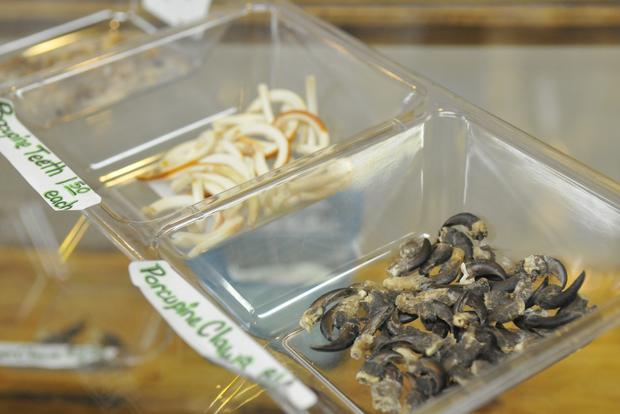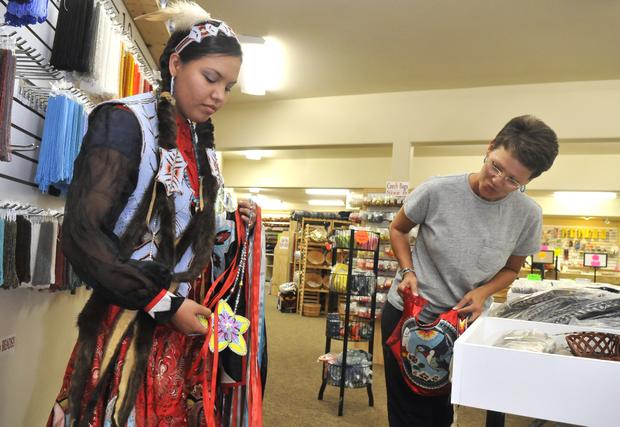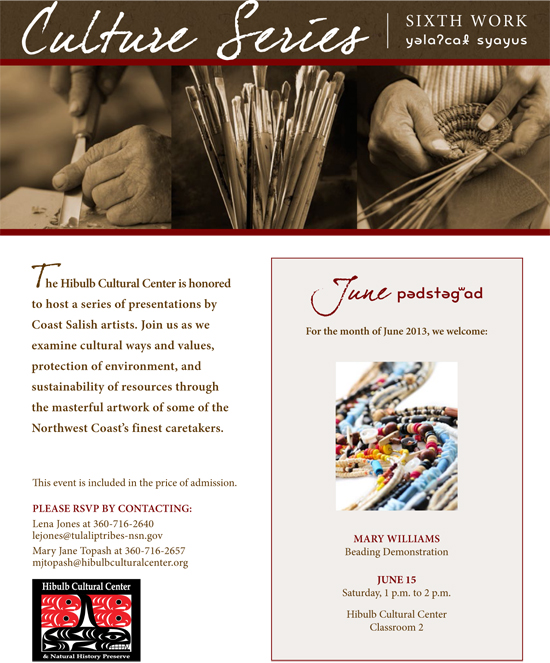Becky Kramer The Spokesman-Review
PLUMMER, Idaho – Peggy Mahoney always wanted to open a regalia store.
She spent hours stitching intricate beadwork on the outfits that her husband and kids wore for powwows and other special occasions, and she knew plenty of other Native American families crafting heirloom-quality clothing that would patronize a local supplier.

Jesse Tinsley photo
Four Shells Regalia Supply started out as a small selection of beads tucked into a corner of War Path Tribal Corp., a convenience store, gas station and gift shop that Mahoney, her husband, Pete, and their children run on the Coeur d’Alene Indian Reservation.
Three years ago, the shop expanded into the regalia store that Mahoney had dreamed about. The shop attracts both native and non-native customers, who can spend an hour or more browsing through the inventory and talking about their current projects.
Four Shells Regalia stocks items that don’t appear in chain craft stores.
There are stacks of brain-tanned buckskin, deer and elk rawhide, and otter, mink and beaver furs. The display case features elk teeth, porcupine quills, cowrie and dentalium shells. And there are hanks of dyed horsehair, packets of face paint and geometric Indian prints in cotton, fleece and wool.
Four Shell’s biggest draw, however, is the three walls devoted to glittering glass beads, which gives the store a rainbow appearance. The beads are imported from the Czech Republic and end up in the intricate beadwork decorating moccasins, jewelry, chokers and other clothing and accessories.

Jesse Tinsley photo
Mahoney, who is Lakota, grew up watching female relatives doing beadwork. “When you are making the items, you put a lot of prayer into them,” she said. “And it’s a way to pass on tradition and culture.”
She said she’s seen a revival of interest in handcrafted regalia in recent years, particularly among the younger generation. One of Four Shell’s clerks, Allyssa Haynes, is already an expert bead worker at 17. Haynes, who will be a high school senior next year, frequently doodles, and her doodles turn into original designs.
Four Shells attracts regular customers from as far as British Columbia, Montana, Oregon and Wyoming.
“They come this way every year or so, and this is one of their main stops,” said Mona Gonzales, another of Four Shell’s clerks.
Vivian and Pete Williams, of Creston, B.C., were browsing in the shop this week.
Both do beadwork – Pete uses a loom – and they make the 2 ½-hour drive to patronize the store because of its large bead selection, Vivian Williams said.
Jeanne Sijohn Gravatt was also shopping for beads. Gravatt, who lives on the Spokane Reservation, has five orders pending for handcrafted gifts, including cradleboards.
Gravatt said that finding a local bead supplier was one of her top priorities after moving to the area from South Dakota. A friend told her about Four Shells.
Gravatt’s husband, Mark, knows not to interrupt her when she’s lost in thought in the store. Her creative wheels are spinning over color combinations and designs.
Four Shells will be busy with tourist traffic through October. But it’s December through February when the most dedicated customers stroll the aisles. They’ll be busy sewing and beading outfits and accessories for the next powwow season.
“It makes you feel pretty good,” Mahoney said of the store’s popularity. “It wasn’t just my hair-brained idea.”




